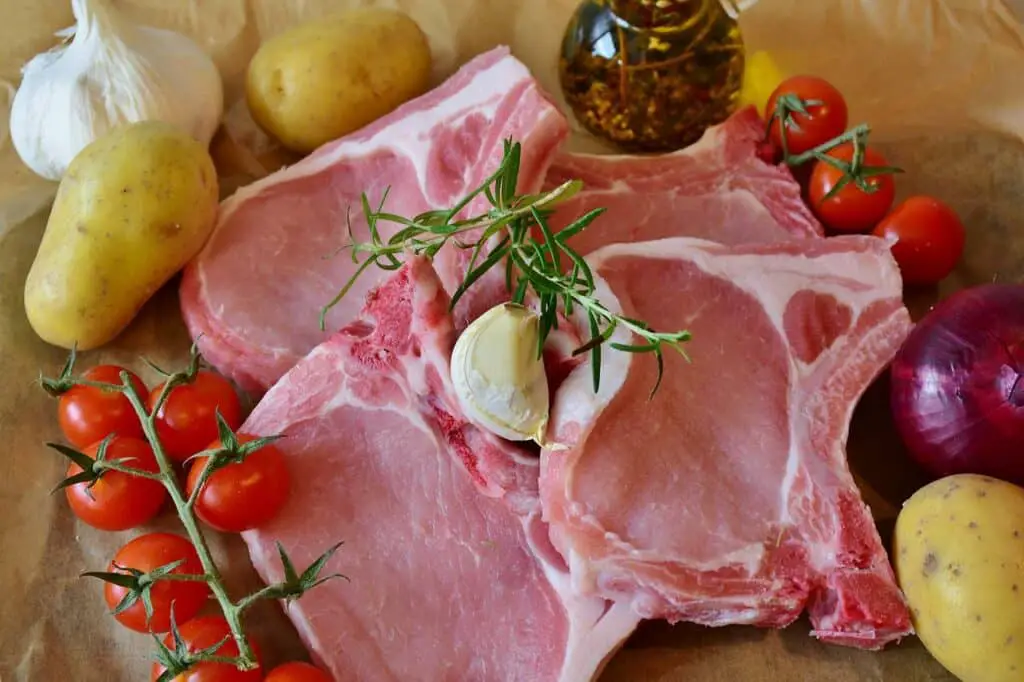Perhaps you are planning a pork roast and wondering if you can give your dog a bone.
Besides, pork neck bones are inexpensive, and it seems like a good way to let your dog have a natural chew treat.
After all, where will all the leftover bones go if you can’t give them to your dog?
So, can dogs eat pork neck bones?
Dogs shouldn’t eat pork bones, cooked or raw.
Pork bones are dangerous for dogs because they can easily splinter and break, causing your dog to choke or cut their gums, throat, or digestive tract.
However, ground pork bones are a safe and healthy treat for your dog.
This article will discuss the risks and dangers of feeding your dog pork bones, whether raw or cooked.
We’ll also talk about what to do if your dog accidentally ingests a pork neck bone.

Raw vs. Cooked Pork Neck Bones
Whether cooked or raw, pork neck bones pose a serious health risk to your dog.
Pork neck bones are small and brittle, which can easily splinter and cause internal damage or perforate your dog’s digestive tract.
In addition, pork neck bones are often smoked or cured, making them even more dangerous for dogs.
The smoking process adds cancer-causing chemicals, and the curing process adds harmful sodium nitrates.
Moreover, pork neck bones are often sold with the skin still on them.
The skin is a choking hazard for dogs and can obstruct your dog’s digestive tract.
To feed your dog pork neck bones, ground them into small pieces using a food processor or grinder.
You can then add the ground pork neck bones to your dog’s food as a treat.
Grounding the bones helps prevent them from splintering and causing internal damage.
It also concentrates the nutrients, so your dog gets the most benefit from the bones.

What are the Risks of Feeding Your Dog Pork Neck Bones?
Pork neck bones pose risks to your dog’s health.
For instance, they are a choking hazard for dogs and can cause an obstruction in your dog’s digestive tract; read below to learn more.
Bone Splinter Damage
Your dog is at risk of bone splinters if they eat pork neck bones.
Bone splinters cause damage to your dog’s mouth, throat, esophagus, and stomach.
If the bone splinter punctures your dog’s stomach or intestine, it causes an infection or perforation.
The symptoms of pork bone splinter damage manifest quickly and include:
- Excessive drooling
- Vomiting
- Diarrhea
- Lethargy
- Abdominal pain
- Refusal to eat
- Blood in vomit or stool
- Swelling of the face or abdomen
- Pain when touching the abdomen
Bowel Obstruction
Bowel obstruction is the other primary health concern associated with feeding pork neck bones to dogs.
If the bone becomes lodged in their digestive tract, your dog develops bowel obstruction.
If this happens, your dog will not be able to pass the bone or any other food through its system.
Surgery is often required to remove the bone and relieve the obstruction.
It’s also possible for bones to get stuck in the gut before reaching the stomach.
If this occurs, it’s called an esophageal blockage.
The symptoms of bowel obstruction or esophageal blockage include coughing, excessive salivating as your dog tries to vomit, retching, and heaving.
You may also see your dog paw at their mouth or rub their face on the ground in an attempt to relieve the discomfort.
If you notice these symptoms, take your dog to the vet immediately.
Dental Issues
In addition to gut emergencies, pork neck bones cause dental problems.
The chewing action required to eat the bone can damage your dog’s teeth.
Their teeth may crack, chip, or break from the hard work of crunching down on the bone.
Although this isn’t life-threatening, it’s painful for your dog and will require a trip to the vet for treatment.
Unfortunately, damage to the teeth is often irreversible; the Vet might suggest removing the damaged tooth.
If you decide to give your dog pork neck bones, it’s best to do so under supervision.
This way, you can take the bone away if your dog is having trouble chewing or if it starts to choke.
My Dog Just Ate Pork Neck Bones: What Next?
If your dog has eaten pork neck bones, you should first call your veterinarian.
They will likely advise you to take your dog in for an examination.
If it’s after-hours, or if your vet is unavailable, you can call a pet poison control hotline.
In the meantime, there are some things you can do to care for your dog at home.
Examine Your Dog
First, take a close look at your dog.
Check for any signs of choking or discomfort.
If your dog has trouble breathing, coughing, or making gagging motions, it may be choking on the bone.
In this case, you’ll need to perform the Heimlich maneuver on your dog.
It’s advisable not to attempt removing anything from your dog’s throat unless you’re trained to do so.
If your dog is choking but can still breathe, get it to the vet immediately.
However, if your dog is not choking, assess them for other signs of illness.
Look for swelling in the face or abdomen and pain when touching the stomach.
Check their vomit and stool for any blood or bone fragments.
Clean Up
Next, you’ll want to clean up any vomit or diarrhea your dog has left behind.
This will help prevent the spread of bacteria and keep your home clean.
If your dog has vomited, use a paper towel or rag to soak up the mess.
Then, dispose of the towel in a sealed plastic bag.
If possible, try to identify what was in the vomit so you can share this information with your vet.
Call Your Vet
Once you’ve examined your dog and cleaned up any mess, it’s time to call your veterinarian.
Describe the symptoms that your dog is experiencing and let them know anything you observed.
Be prepared to answer questions about your dog’s diet and when they ate the pork neck bone.
Your vet will likely want to see your dog for an examination.
They may also recommend bringing in a sample of your dog’s vomit or stool.
This will help them determine the severity of the problem and whether or not surgery is necessary.
Don’t Force your Dog to Vomit
In some cases, your vet may recommend inducing vomiting.
However, this is only safe if it’s done within two hours of your dog eating the pork neck bone.
Inducing vomiting any later than this can make the obstruction worse.
It’s also important not to induce vomiting if your dog is showing signs of choking or if they’re having trouble breathing.
This could cause them to aspirate or inhale the vomit into their lungs leading to a serious infection called aspiration pneumonia.
If your vet does recommend inducing vomiting, they will likely give you specific instructions on how to do so.
In most cases, this is done by giving your dog a hydrogen peroxide and water solution.
Watch For Changes
After taking your dog to the vet, it’s important to watch for any changes in their condition.
This includes vomiting, diarrhea, coughing, or difficulty breathing.
If you notice any of these symptoms, call your vet immediately.
You should also watch your dog’s stool for any blood or bone fragments.
Can my Dog Gain any Nutritional Benefits from Eating Pork Neck Bones?
Pork neck bones are a good source of phosphorus, calcium, and other minerals essential for your dog’s health.
They also contain collagen, which is good for your dog’s joints.
However, feeding your dog too many pork neck bones can cause constipation or diarrhea due to the high-fat content.
Conclusion
You shouldn’t feed your dog pork neck bones regularly.
While they may be a good source of nutrients, they can also cause choking or other serious health problems.
If your dog eats pork neck bone, it’s important to watch for any signs of illness and call your vet right away.
- What Dog Breeds Have Pink Skin? - March 24, 2023
- What Are the Most Inspiring Dog Breeding Quotes? - March 20, 2023
- Can Pheromone Spray Help Improve Dog Breeding Results? - March 19, 2023








